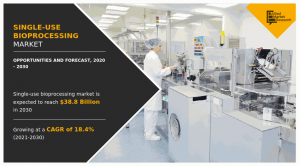
Single-use bioprocessing is a method of producing biopharmaceuticals using disposable components, such as bags, filters, and tubing, that are used only once and then discarded after use. This approach is also sometimes referred to as disposable bioprocessing. In traditional bioprocessing, many of the components used to produce biopharmaceuticals are made of stainless steel and are cleaned and sterilized after each use. The global single-use bioprocessing market size was valued at $7.0 billion in 2020, and is projected to reach $38.8 billion by 2030, growing at a CAGR of 18.4% from 2021 to 2030.
What are the advantages of single-use bioprocessing?
- Flexibility: Single-use bioprocessing allows for more flexibility in terms of production scale and manufacturing workflows. As single-use components are used only once, biomanufacturing facilities can easily change their production volumes or even shift production between different products without having to invest in additional fixed stainless steel equipment.
- Cost-effectiveness: Since single-use components do not require cleaning or sterilization between uses, the overall cost of the manufacturing process can be lower. Moreover, because single-use bioprocessing does not require a large investment in stainless steel equipment, it can be a more cost-effective approach for smaller biotech companies or contract manufacturing organizations.
- Reduced risk of contamination: Single-use components are pre-sterilized and packaged in sterile conditions, which helps to reduce the risk of contamination during the manufacturing process.
Single-use bioprocessing has become increasingly popular in recent years, particularly for the production of biologics, such as monoclonal antibodies, which are highly complex and require large-scale manufacturing. However, it is important to note that single-use bioprocessing may not be suitable for all biopharmaceutical production, as it may not be cost-effective for large-scale production or may not be compatible with certain manufacturing processes.
Download Free Sample PDF:
https://www.alliedmarketresearch.com/request-sample/675
Single-use systems are widely used in the biotech industry due to their many advantages over traditional stainless steel systems. Some of the benefits of single-use systems include:
- Reduced cross-contamination risk: Single-use systems come pre-sterilized and are used only once, which minimizes the risk of cross-contamination and eliminates the need for cleaning and sterilization between batches.
- Improved flexibility: Single-use systems can be easily adapted to different production scales and workflows, which makes them more flexible than traditional stainless steel systems.
- Lower capital investment: Single-use systems require a lower capital investment than traditional stainless steel systems, which can make them more cost-effective for smaller biotech companies or contract manufacturers.
- Reduced environmental impact: Single-use systems generate less wastewater and require less energy than traditional stainless steel systems, which can reduce their environmental impact.
Single-use systems are widely used in many stages of biopharmaceutical manufacturing, including upstream and downstream processing, formulation, filling, and packaging. They are particularly useful for the production of biologics, such as monoclonal antibodies, which are highly complex and require large-scale manufacturing.
Overall, single-use systems in biotechnology offer many advantages over traditional stainless steel systems, and their use is expected to continue to grow as the biotech industry expands and evolves.
Single-use and disposable are similar terms but they have slightly different meanings.
Single-use refers to an item or component that is intended to be used only once and then discarded. Single-use items are typically made of plastic or other lightweight materials and are designed to be cost-effective, easy to use, and require minimal cleaning or maintenance.
Single-use items are often used in medical and biotech applications, such as single-use medical devices, single-use bioreactors, and single-use chromatography columns.
Disposable, on the other hand, is a broader term that refers to any item or product that is designed to be thrown away after use, regardless of whether it is used once or multiple times. Disposable products can be made of various materials, including plastic, paper, or cloth.
Disposable products are used in a wide variety of applications, from household products such as paper towels and plastic cutlery, to medical products such as disposable gloves and surgical masks.
In summary, the main difference between single-use and disposable is that single-use refers to items that are intended to be used only once, while disposable refers to items that are intended to be thrown away after use, regardless of whether they are used once or multiple times.
Contact:
David Correa
USA/Canada (Toll Free): +1-800-792-5285, +1-503-894-6022

